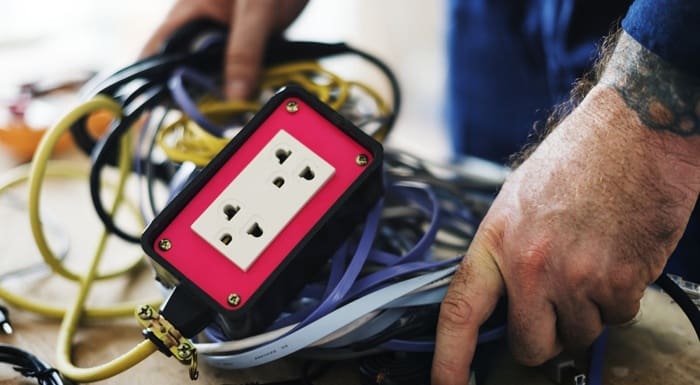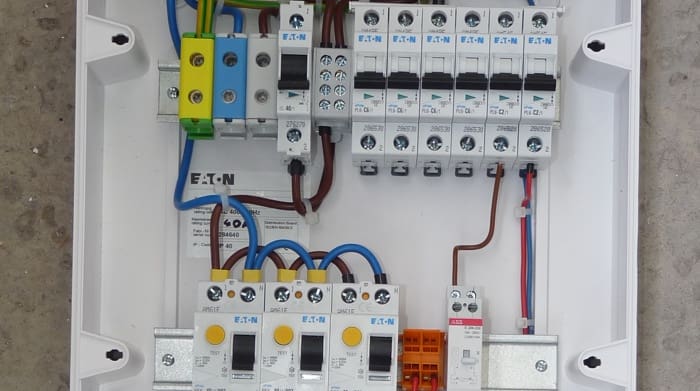What Sellers Can Expect from an Electrical Home Inspection
- Published on
- 3-4 min read
-
 Valerie Kalfrin Contributing AuthorClose
Valerie Kalfrin Contributing AuthorClose Valerie Kalfrin Contributing Author
Valerie Kalfrin Contributing AuthorValerie Kalfrin is a multiple award-winning journalist, film and fiction fan, and creative storyteller with a knack for detailed, engaging stories.
A home inspection covers a lot of details to make sure that the house you’re selling is up to code, safe for a potential buyer, and doesn’t have a costly hidden maintenance issue. But even though home inspectors are trained to identify a lot of issues, they might recommend that a buyer call on an electrician’s expertise for an electrical home inspection.
Jeff Glover, a top-selling real estate agent in the Detroit, Michigan area with 16 years of experience, said that one out of every 40 or 50 homes that he lists needs an electrical home inspection.
That’s often because of a home’s age, its wiring, and whether the electrical service panel has been updated. “A lot of older homes have different wiring,” said Glover “There’s a wiring called knob-and-tube that still exists in a lot of homes today. There are some complications with that.”
Here’s what you need to know about this particular home inspection and how to spot any potential problems that might need a professional’s help.

Electrical home inspections 101: Keeping your home’s wiring safe and up to code
Your home’s electrical system is a vital component of protecting your family—and anyone who buys your home. Electrical distribution or lighting equipment in the home remains the 4th leading cause of home fires, according to the National Fire Prevention Association.
The National Fire Protection Agency said in a 2017 report that electrical distribution, lighting, and power transfer equipment was involved in 57% of home structure fires from 2010 to 2014.
In all, U.S. firefighters from 2010 to 2014 responded to an estimated annual average of 45,210 home structure fires with some type of electrical failure or malfunction, the NFPA said. These fires caused an estimated $1.4 billion in property damage and killed an estimated 420 people and injured about 1,370, NFPA statistics show.
Homeowners can schedule an electrical inspection once a year as a preventive safety measure; it’s also sometimes requested by a lender when refinancing your home.
Beyond that, the Electrical Safety Foundation International (ESFI) of Rosslyn, Virginia, the premier nonprofit authority dedicated to promoting electrical safety at home and in the workplace, recommends an electrical system inspection for anyone purchasing a home that was previously owned.
The ESFI also recommends an electrical system inspection if your home meets the following conditions:
- Your home is 40 years old or older;
- Your home has undergone a major renovation;
- You’ve added major new appliances within the last 10 years.
Who performs an electrical home inspection? What does it cost?
A licensed electrician or electrical contractor performs these inspections, which range in price depending on the size of the building, the contractor used, and who’s requesting the inspection: the seller, the buyer, a lender or an insurance company.
Glover says that a home electrical system inspection costs about $150 to $200. Some companies charge slightly less, according to the home service directory Thumbtack, which notes that electricians cost a national average of $75 to $125.

What is the National Electric Code?
The National Electric Code (NEC) states the benchmark for safe electrical design, installation, and inspection of electrical equipment of all types.
As of 2017, the NEC has been revised 15 times since 1975, the ESFI says. So what was considered safe in your home’s electrical system years ago might not be safe any longer, especially with today’s technology.
For public and private premises, including buildings, mobile homes, recreational vehicles, floating buildings, and other structures, the NEC covers:
- the installation and removal of electrical conductors, equipment and raceways (the enclosed conduits that form physical pathways for electrical wiring);
- signaling and communications conductors, equipment, and raceways;
- optical fiber cables and raceways.
What are some of the most common home electrical issues?
These are the most common electrical issues that home inspectors find during home inspections:
- Exposed wiring and splices: wires spliced or taped together and not in a junction box; or an uncovered junction box, exposing the wires
- Ungrounded three-prong plugs (outlets): having grounded outlets helps prevent electrical shocks; homes built before the early 1960s often have a two-wire system, with no ground wire, even if the outlet has room for a three-pronged plug
- Painted outlets: paint in an outlet’s slots can cause overheating
- Double tapping of circuit breakers: this means that two or more energized (or “hot”) wires run to one circuit breaker; often seen in older homes or those with extensive remodeling
- Reversed polarity: this means that the hot, neutral and ground slots for a plug have been mixed up somehow; this can damage the electrical device in that outlet or cause a shock
- Improperly modified electrical panels: covers a range of modifications that result in signs such as switches or outlets working intermittently, hot ceiling fixtures, and flickering lights.
- Missing knockouts in panels: round or rectangular shapes that are missing inside an electrical panel
- Knob-and-tube wiring: sometimes called KT, this is the first generation of electrical wiring; usually in homes built roughly between the 1900s and 1940s. Uses no ground wire and no protection when a fault occurs
- Aluminum wiring: sometimes substituted for copper branch-circuit wiring because of cost from 1965 to 1973; becomes defective faster than copper because of the metal’s qualities, covering overheating and other hazards
- Federal Pacific breaker panels: often in homes built between 1950 and 1990; multiple tests have shown that one in four is defective.
- No GFCI protection: Ground fault circuit interrupters, or GFCIs, are outlets that interrupt an abnormal current flow to reduce the chance of electric shock. They’re usually installed in kitchens, bathrooms, and other areas where outlets may come in contact with liquid. (A GFCI outlet has two buttons in the center; if the outlet stops working, push the “Reset” button to rest the breaker.)
- More than one neutral wire in a slot of an electrical panel: one wire can slip out if the set screw does not hold them firmly

What does a home electrical system inspection involve?
Inspection Certification Associates (ICA) of Chicago, Illinois, which provides national online training and certification of home inspectors, says electrical inspectors must examine several segments of your home’s electrical system, including:
- Service panels and subpanels (what some people may call a circuit breaker or fuse box):
They’ll typically remove the cover, noting that nothing inside the panel is humming or hot—and that there are no fuses instead of circuit breakers. They’ll also check for loose wires, that wires are the right gauge for the breakers, and that the main breaker is the right size. (Smaller than 100 amps is not enough for the electrical needs of a modern family, ICA says.) - Outlets (or receptacles): They’ll use a handheld device, a multimeter, to probe the outlet and check the voltage and ground wire.
- Light switches and fixtures: They’ll take a representative number of installed lighting fixtures, receptacles, and switches.
- GFCI circuits and arc-fault circuit interrupters (AFCIs): The absence of GFCIs, AFCIs (which interrupt the circuit when it detects an electric arc), or other “overcurrent protection devices.”
- The type of wiring: such as aluminum, knob-and-tube, or copper, and whether any of it is exposed or loose.
Some electrical issues take simple and relatively inexpensive fixes. Decker Home Inspection Services in Skokie, Ill., for instance, charges $10 to $15 each for rewiring, correcting or reversing polarity on an electrical outlet. For replacing an old outlet with a GFCI or AFCi outlet, this company charges $40 to $60 per outlet.
Other services are more costly. Electricians in your area may vary in price, of course, but Decker charges $75 to $125 to replace a circuit breaker; $300 to $500 to add a 240 volt circuit (for an electric dryer, stove, or AC unit); and $1,500 to $2,500 to upgrade a home to 200 amp service.
Rewiring an entire home can cost from $3,000 to $30,000, depending on your home’s size and the extent of your electrical needs.
What electrical system items will you be required to fix before you sell the house?
Everything in real estate is negotiable including inspection requests. But if an electrical home inspection yields issues with the house, you’ll likely be on the hook to remedy any problems that could pose a threat to the buyer’s health or safety such as faulty wiring or fire hazards. The absence of GFCIs is also a common thing home inspectors find and buyer’s agents will recommend that their client ask the seller to fix.
More cosmetic electrical issues—such as changing out a light fixture or light-switch plate that is fully functional—would not be something you’d want to agree to change out per a buyer’s request unless you were in a weak position of leverage.
When in doubt, consult with your real estate agent about whether you should get an electrical home inspection before putting the house on the market or how to handle this extra step if it does arise during closing. Experienced real estate professionals will have been through this before with other sellers and be able to guide you through any surprises or expensive fixes for an ultimately successful sale.
Article Image Source: (rawpixel/ Unsplash)
